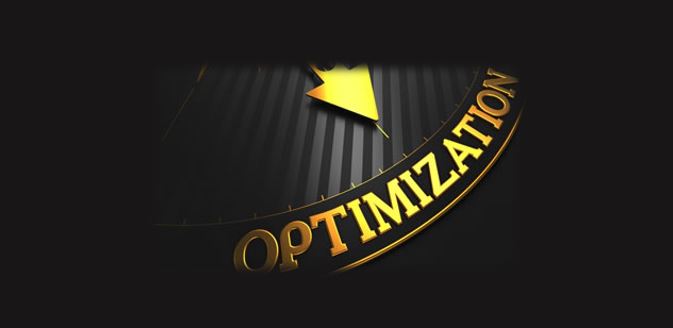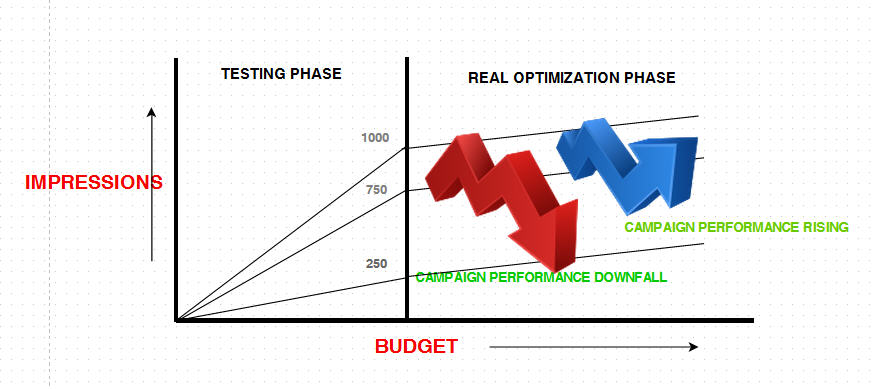
The word Optimization itself defines it’s meaning whether it be an advertising field or any other.
When you look at the definition of Optimization it says ” to make as effective, perfect, or useful as possible ” or “ to get the most out of ” . Same as what it defines we do in online advertising too, we optimize every campaign that we work on so that we can take out the best of it and serve the Ads at the best level making it cost effective too!
Optimization means finding an alternative with the most cost-effective or highest achievable performance under the given constraints, by maximizing desired factors and minimizing undesired ones, meaning – It is natural that some ads perform better than other ads. It means that some ads generate more revenue, more clicks, more conversions, a higher click-through ratio, or a higher conversion ratio. With this feature, you can always choose to display the better performing ads more often and his increases the return over investment(ROI) for better ads and raises a flag on poor ads that should be revised /improved or any changes that may help the specific Ad to perform better too!
Optimization requires changes at every step and these changes help advertisers save money by reducing wasted, ineffective impressions and ensuring that the right message is delivered to the right consumers, but the changes cannot be any step as there are some rules to be followed for the correct way of optimizing online branding campaigns.
Optimization seems to be an easy one but needs a lot of strategies, analytic, common sense, ideas and of course a lot of experience can be the best help. It does come up with the experience as there is no hard and fast rule. There can be different tips and factors on which optimization can be done. Some of the factors are :
- Clicks – Ads with more clicks than other ads in the same period will be served more often.
- Conversion – Ads with more conversions than other ads in the same period will be served more often.
- CTR – Ads with a higher CTR than other ads in the same period will be served more often.
- Sites having higher CPC but almost no conversion or less should be blocked.
- Cookie Users: Almost 30% of users don’t accept cookies, so not including these users may hamper the campaign performance. Targeting the cookie user will bring better performance too.
- Budget(min cost) – The budget that has been allocated for every publisher on which the sites has to be served on, it can be changed as per the requirements.
An accurate and up-to-date optimization requires a continuous stream of input data. The ad optimization feature takes into account all the data that an ad has when it is served across all zones. Thus, it is a holistic approach. Optimization is done for the ad, based on its whole performance in all zones that it is linked to, not just within any specific zone.
But as I said there is no such hard and fast rule to make the campaign successful in one click. Every Ad server has its own rules and settings to follow for better optimization.
But one thing is common with every optimization rule is TESTING, the first phase of optimization is testing phase where some budgets and impressions are spent for testing purpose and second phase called as OPTIMIZATION phase where actual optimization for the campaign is done.
Normally 1000 impressions are spent on every publisher so that it can catch up the pacing and after looking up the performance and response the optimization is done accordingly. It’s true that it totally depends upon campaign to campaign, testing can be very small at low budget campaigns which indirectly means now the campaign response totally depends upon the probability of catching the user , sometimes 100 impressions get us a conversion and sometimes a lot of testing don’t help, so as I said optimization has no rule to make you sure of giving success but yes the probability can be low and high always.
Let’s try to understand the normal process of optimization with the help of the below graph :

As already said the optimization process is generally divided into two phases, the testing, and the optimization phase.
In the graph, the x-axis is IMPRESSIONS and the y-axis is BUDGET, as we know they are directly proportional to each other, the more the budget you spend the more impression you give and when more impressions are served it is natural that some budgets must be spent. In the above scenario, when we are in testing phase we started to serve some impressions, the number of impressions to be served for a campaign in testing phase depends upon the budget of the campaign, normally we serve 1000 impressions for best practice in testing. So as when we complete the serving of 1000 impressions we start the real process of optimization and thus reaching the next phase called as OPTIMIZATION phase. Here we continue serving the impression and using the budget as per the campaign position, if the campaign is performing fine we make no changes and if the campaign performance is degrading we make changes as looking into a campaign, rather by increasing or decreasing the CPM or other metrics discussed above.
This is the way the optimization process works !!
Creative Optimization: Now what’s this? well, there are times when the creative is also or needs to be changed for better optimization, creative can also be a major reason for low performance, so the changing of creative for better optimization result is called creative optimization.
OVER AND UNDER-DELIVERY OF CAMPAIGN: SOLUTION IN OPTIMIZATION PROCESS !!
Before I gave up some solutions or points, just wanted to let you know that optimizing the campaign is a real-time job and changes required are always as per the scenario and the campaign type(CPA, CPM or CPC, etc.) The solution cannot be same for every campaign, it differs with the hamper in the campaign. The below points are the general solutions that are always processed when a campaign is underperforming or overperforming…
- The first and the foremost thing to be done is to check the campaign setup properly that everything is set up as per requirement or not.
- Check the targeting that the campaign is targeted to right users or not.
- Increase the priority of the campaign if it’s too low. This won’t affect much but can be helpful at times.
- Increase the budget if the campaign is under-delivery or decrease the budget if the campaign is over-delivered.
- Make the changes with the running date, it affects the campaign directly. You can always increase the end date if the campaign is over-delivering or vice versa.
- Expand the targeting for under delivery cases.
- Also, check the frequency capping if applied.
- Make the changes with the CPM, or CPC ..increase or decrease as per the campaign requirement. Brings quick effect!
- If all the setup and everything seems to be good , you can get the IO revised.
- AVOID NUMBER OF CHANGES : Making number of changes will lead to more downfall of the campaign performance , it shouldn’t be like trying everything in and waiting to see what works and what not , this will only result in a lot of wasted media spend.There should always be minimum change and the best practice is to plan initially as per the campaign and than make changes.
- BE PATIENT: Always be patient while optimizing the campaign, don’t expect a fast result, observe the campaign after making any change.
- ABRUPT DECISIONS: Another thing to be kept in mind always is please don’t make any abrupt decisions while optimizing, it shouldn’t be too before or too late. There are times people starting making changes so as to get the best benefit out of the campaign and reduce the extra waste but it’s not the correct way to handle the campaign. As already discussed that you need to be patient, the campaign cannot start delivering in one go, frequency is also an important factor in optimization.
Hi, Thanks for the valuable knowledge share. However, I could not understand the point
“Make the changes with the running date , it affects the campaign directly. You can always increase the end date if the campaign is over delivering or vice versa.”
Increasing the end date of over-delivering campaigns will give more space to the campaign to over deliver further. Can you please correct me if I am wrong.
Hey Pradeep,
Changing the running always effects the campaign delivery. Every ad server has it’s own algorithm but generally this works. When a budget is allocated to a placement or campaign or creative (depending upon different platforms) it divides the budget day wise as per the total number of days the creative has to serve, so if you extend the end date the delivery will slow down, and when you get the required pacing you need to correct the end date as per IO. This is a good practice for long campaigns. But you need to be cautious that you don’t forget to correct the date as it will of course over deliver.
I hope it make sense to you 🙂
Hi Avinash, Thanks a lot for your response. Yes, it does make sense. 🙂
Great to know that. Cheers!
@Pradeep SG – are you from Glam Media?
Learns a lot 🙂
Great post!
Testing only one change at a time is one of the most important items on this list.
I’ve seen to many companies / clients want to make way to may changes at once, which skews all of their data…
Exactly Brent
Hello,
In the article you mention that “Not targeting users that have disabled cookies will hamper the performance” but then it is mentioned that targeting cookied users will improve performance.
Could you please explain what is the difference?
Thanks,
Sam DV
Hey Sam,
Yes, that means a lot of advertisers ignores the users who have not enabled cookies which makes the advertiser lose 30% audience, hence could be a reason for low performance. And yes, it is perfectly correct that targeted cookied users improve the performance since we know a little more about the user than non-cookied user.
Let us know if there is still some confusion.
Regards,
kOA